AMD Ryzen 5 2400G and Ryzen 3 2200G Core Frequency Scaling: An Analysis
by Gavin Bonshor on June 20, 2018 10:05 AM EST- Posted in
- CPUs
- AMD
- Zen
- APU
- Vega
- Ryzen
- Ryzen 5
- Ryzen 3
- Scaling
- CPU Frequency
- Ryzen 3 2200G
- Ryzen 5 2400G
Integrated Graphics Performance
As stated on the first page, here we take both APUs from 3.5 GHz to 4.0 GHz in 100 MHz increments and run our testing suite at each stage. This is a 14.3% increase in clock speed, however when it comes to gaming it can be unpredictable where those gains are going to come from.
Civilization 6
First up in our APU gaming tests is Civilization 6. Originally penned by Sid Meier and his team, the Civ series of turn-based strategy games are a cult classic, and many an excuse for an all-nighter trying to get Gandhi to declare war on you due to an integer overflow. Truth be told I never actually played the first version, but every edition from the second to the sixth, including the fourth as voiced by the late Leonard Nimoy, it a game that is easy to pick up, but hard to master.
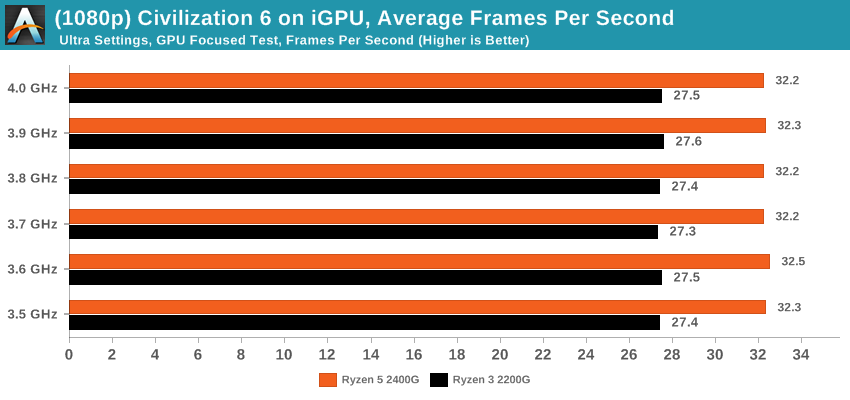

For a turn-based game, frame rate is not as vital for Civ 6, so we run our settings at a standard 'real-world' level of detail. At this level, the CPU frequency does not seem to matter so much.
Ashes of the Singularity (DX12)
Seen as the holy child of DX12, Ashes of the Singularity (AoTS, or just Ashes) has been the first title to actively go and explore as many of the DX12 features as it possibly can. Stardock, the developer behind the Nitrous engine which powers the game, has ensured that the real-time strategy title takes advantage of multiple cores and multiple graphics cards, in as many configurations as possible.
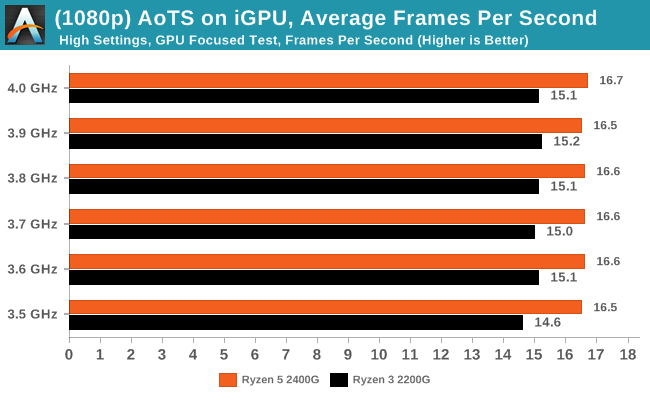
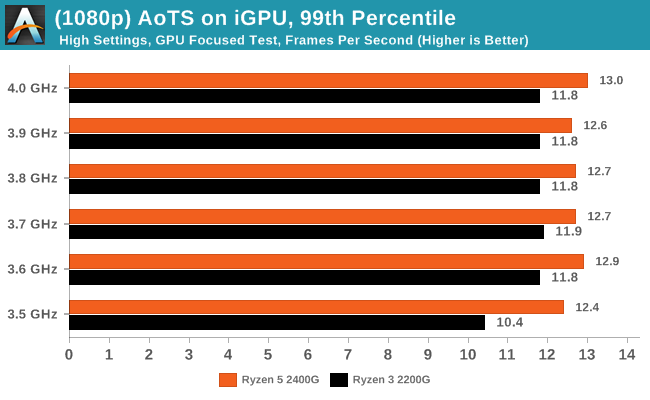
AoTS seems to get a small uplift in percentile numbers coming from a 3.5 GHz base, although the performance gain does not seem to scale up to 4.0 GHz so much.
Rise Of The Tomb Raider (DX12)
One of the newest games in the gaming benchmark suite is Rise of the Tomb Raider (RoTR), developed by Crystal Dynamics, and the sequel to the popular Tomb Raider which was loved for its automated benchmark mode. But don’t let that fool you: the benchmark mode in RoTR is very much different this time around.
Visually, the previous Tomb Raider pushed realism to the limits with features such as TressFX, and the new RoTR goes one stage further when it comes to graphics fidelity. This leads to an interesting set of requirements in hardware: some sections of the game are typically GPU limited, whereas others with a lot of long-range physics can be CPU limited, depending on how the driver can translate the DirectX 12 workload.
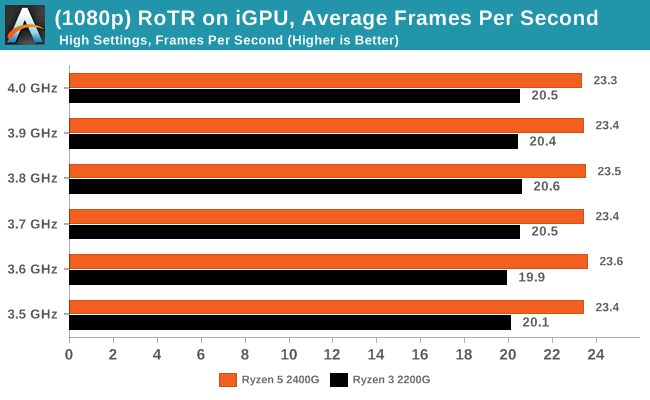
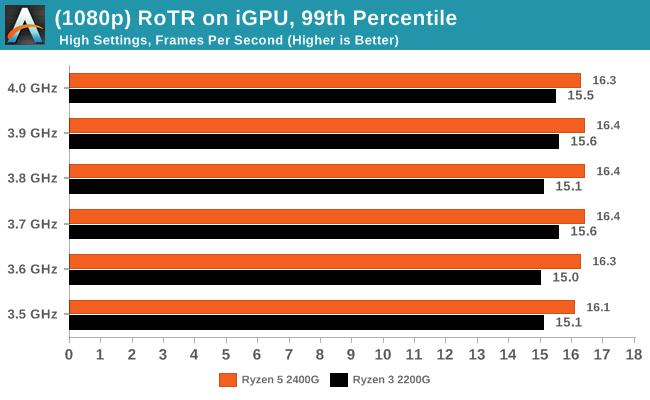













29 Comments
View All Comments
eastcoast_pete - Thursday, June 21, 2018 - link
I hear your point. What worries me about buying second hand GPU especially nowadays is that there is no way to know whether it was used to mine crypto 24/7 for the last 2-3 years or not. Semiconductors can wear out if used for thousands of hours both overvolted and at above normal temps; both can really affect not just the GPU, but especially also the memory.The downside of a 980 or 970 (which wasn't as much at risk for cryptomining) is the now outdated HDMI standard. But yes, just for gaming, they can do.
Lolimaster - Friday, June 22, 2018 - link
A CM Hyper 212X is cheap and it's one the best bang for buck coolers. 16GB of ram is expensive if you want 2400 o 3000 CL15. 8GB is just too low, the igpu needs some of it and many games (2015+ already need 6GB+ of system memory)eastcoast_pete - Thursday, June 21, 2018 - link
Thanks for the link! Yes, those results are REALLY interesting. They used stock 2200G and 2400G, no delidding, no undervolting of the CPU, and on stock heatsinks, and got quite an increase, especially when they also used faster memory (to OC memory speed also) . Downside was notable increase in power draw and the stock cooler's fan running at full tilt.So, Gavin's delidded APUs with their better heatsinks should do even better. The most notable thing in that German article was that the way to the overclock mountain (stable at 1600 Mhz stock cooler etc.) led through a valley of tears, i.e. the APUs crashed reliably when the iGPU was mildly overclocked, but then became stable again at higher iGPU clock speeds and voltage. They actually got some statement from AMD that AMD knows about that strange behavior, but apparently has no explanation for it. But then - running more stable if I run it even faster - bring it!
808Hilo - Friday, June 22, 2018 - link
A R3 is not really an amazing feat. It's a defective R7 with core, lane, fabric, pinout defects. The rest of the chip is run at low speed because the integrity is affected. Not sure anyone is getting their money worth here.Lolimaster - Friday, June 22, 2018 - link
I don't get this nonsense articles on an APU were the MAIN STAR IS THE IGPU. On some builds there mixed results when the gpu frequency jumped around 200-1200Mhz (hence some funny low 0.1-1% lows in benchmarks).It's all about OC the igpu forgetting about the cpu part and addressing/fixing igpu clock rubber band effect, sometimes disabling boost for cpu, increase soc voltage, etc.
Galatian - Friday, June 22, 2018 - link
I'm going to question the results a little bit. For me it looks like that the only ”jump” in performance you get in games occurs whenever you hit an OC over the standard boost clock, e.g. 3700 MHz on the 2400G. I would suspect that you are simply preventing some core parking or some other aggressive power management feature while applying the OC. That would explain the odd numbers with when you increase the OC.That being said I would say a CPU OC doesn't really make sense. An undervolting test to see where the sweet spot lies would be nice though.
melgross - Monday, June 25, 2018 - link
Frankly, the result of all these tests seems to be that overclocking isn’t doing much of anything useful, at least, not the small amounts we see here with AMD.5% is never going to be noticed. Several studies done a number of years ago showed that you need at least an overall 10% improvement in speed for it to even be noticeable. 15% would be barely noticeable.
For heavy database workloads that take place over hours, or long rendering tasks, it will make a difference, but for gaming, which this article is overly interested in, nada!
Allan_Hundeboll - Monday, July 2, 2018 - link
Benchmarks @46W cTDP would be interestingV900 - Friday, September 28, 2018 - link
The 2200G makes sense for an absolute budget system.(Though if you're starting from rock bottom and also need to buy a cabinet, motherboard, RAM, etc. you'll probably be better off taking that money and buying a used computer. You can get some really good deals for less than 500$)
The 2400G however? Not so much. The price is too high and the performance too low to compete with an Intel Pentium/Nvidia 1030 solution.
Or if you want to spend a few dollars more and find a good deal: An Intel Pentium/Nvidia 1050.